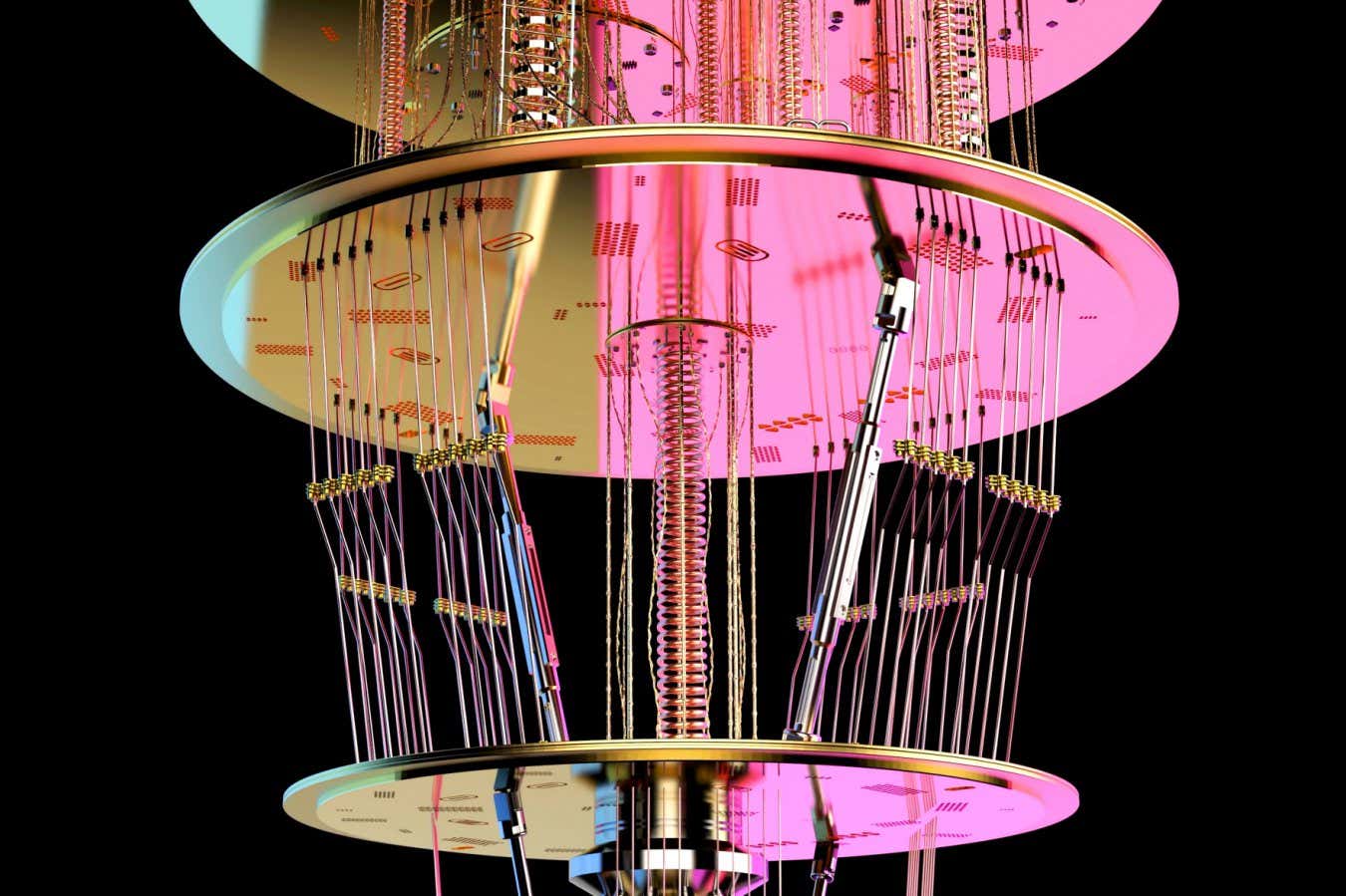

3D rendering of a quantum computer’s chandelier-like structure
Shutterstock / Phonlamai Photo
Eleven years ago, I was just getting a start on my PhD in theoretical physics, and to be honest with you I never thought about quantum computers, or writing about them, at all. Meanwhile, New Scientist staff were hard at work putting together the world’s first “Quantum computer buyer’s guide” (we’ve always been ahead of the curve). Looking through it reveals what a different time it was – John Martinis at University of California, Santa Barbara got a shout out for working on an array of only nine qubits, and just last week he was awarded the Nobel Prize in Physics. Meanwhile, quantum computers made from neutral atoms, which have taken the field by storm in recent years, are not even mentioned. This made me wonder: what would a quantum computer buyer’s guide look like today?
There are currently about 80 companies across the world manufacturing quantum computing hardware. Because I report on quantum computing, I have had a chance to watch it grow as an industry from up close – and to hear an awful lot of sales pitches. If you thought deciding between an iPhone and an Android phone is tough, try being on the press list for dozens of quantum computing start-ups.
Sure, a lot of hype comes with marketing, but some of the difficulty in comparing these devices and approaches stems from the fact that there is currently no consensus on the best way to build a quantum computer. For instance, you could opt for qubits made from superconducting circuits, extremely cold ions, light or several other options. How do you weigh the differences between these machines when they have fundamentally different parts? It helps to focus on the performance of each quantum computer.
This is a notable shift from the early days of quantum computing, where the champions among these novel devices were determined by the number of qubits – the most basic building blocks of quantum information processing – a machine had. Several research teams have now broken the 1000-qubit barrier and the road towards ever larger numbers of qubits seems to look clearer every day. Researchers are now working out how to leverage standard manufacturing techniques, like making qubits made from silicon and even using AI to make their quantum computers bigger – and more powerful.
In an ideal world, more qubits would always mean more computational power because this would allow the quantum computer to tackle more complex problems. In our actual world, making sure every new qubit you add doesn’t worsen the performance of the ones you already have has proven to be a huge technical challenge. So, it’s not just the number of qubits you have, but also how well they can hold onto information and how well they can “talk” to each other without that information degrading. A quantum computer could have millions of qubits and be essentially useless if those qubits are prone to glitches that introduce errors into calculations.
This glitchiness – or noise – can be quantified in metrics such as “gate fidelity”, which captures how accurately you can make a qubit or a pair of qubits do something, and “coherence time”, which puts a number to how long a qubit can stay in a quantum state that is useful to you. But these measures land us right back into the nitty-gritty details of quantum computing hardware. Annoyingly, even if those metrics are great, you still have to worry about how difficult it might be to input data into your quantum computer and start the computation, as well as whether you’ll run into trouble when you try to read out the final result.
Part of the remarkable growth of the quantum computing industry has been due to the rise of companies specialising in qubit control and other parts of quantum computers that deal with the tricky interface between these devices’ quantum innards and their very non-quantum users. A proper 2025 quantum computer buyer’s guide would have to include all these add-ons. You’d have to choose your qubits, but also a qubit control system and some mechanism for correcting those qubits’ errors. I’ve had a chance to speak with researchers who are even developing an operating system for quantum computers, so in a few years that may also become part of your shopping list.
If I had to assemble a near-term wish list, I would hedge my bets on a machine that can perform at least a million operations – roughly, a quantum computing program that has a million steps – with very low error rates and as much built-in error correction as possible. John Preskill at the California Institute of Technology calls this the “megaquop” machine. Last year he told me he believes such a machine would be just powerful enough to be fault-tolerant, or error-proof, and to make scientifically meaningful discoveries. But we’re not there yet. The quantum computers we have today are running tens of thousands of operations, and have only demonstrated error-correction for relatively small tasks.
In some sense, today’s quantum computers are in an era of adolescence, maturing towards usefulness but still going through growing pains. Because of this, the question I find myself asking the quantum computer merchants in my inbox most often is: “What can this machine actually do?”
This is where we have to not only compare different types of quantum computers, but pit them against their conventional counterparts as well. Quantum hardware is costly and difficult to build, so when would it truly be the only viable option for solving a problem?
One way to answer this question is to try to identify calculations conventional computers could not complete unless they had unlimited amounts of time. Colloquially, this goes by the name of “quantum supremacy”, and it keeps mathematicians and complexity theorists up at night as much as it steals sleep from quantum engineers. Examples of quantum supremacy do exist, but they are troublesome. To be meaningful, they must be practical – you have to be able to build a machine that can execute them – and they must be provable such that you can be sure a clever mathematician could not get a conventional computer to execute them after all.
In 1994, physicist Peter Shor developed a quantum computing algorithm for factoring large numbers which could be used to easily break the most common encryption methods currently used by, for instance, the world’s banks. A big enough quantum computer that corrects its own errors could practically run this algorithm, but mathematicians have so far not been able to rigorously prove classical computers could never factor large numbers as efficiently. The most notable quantum supremacy claims fall into this category, too – and some of them were eventually bested by classical machines. Quantum supremacy demonstrations that are still standing also do not yet seem to be useful and are primarily designed to showcase the quantumness of the computer that completed them.
On the opposite side of the spectrum are problems in the mathematical field of “query complexity”, where the supremacy of the quantum approach is rigorously provable, but there are no related algorithms that would be practical to implement or do something unambiguously useful. A recent experiment also introduced the idea of “quantum information supremacy”, where a quantum computer solved a task using fewer qubits than the number of bits required to solve the same problem on a classical computer. Here, the resource the quantum computer needed less of was not time but rather the number of physical building blocks. This may sound promising because it implies a quantum computer could do something without having to be made huge first, but I would not advise you to buy it for one simple reason – the task in question yet again had no obvious uses in the real world.
Certainly, there are real-world problems that seem like a good match for quantum computer algorithms, such as determining the properties of molecules that are important in agriculture and medicine, or solving logistics problems like scheduling flights. But I have to say “seem” because the truth is researchers don’t have all the details down yet.
For instance, in recent study on possible uses of quantum computing for genomics, Aurora Maurizio at San Raffaele Scientific Institute in Italy and Guglielmo Mazzola at the University of Zurich in Switzerland wrote that conventional computing methods are so good that “quantum computing could offer a speedup in the near future only for a specific subset of hard enough tasks”. The message of their study is that even though at first glance combinatorics problems in genomics look like an area where a quantum computer could accelerate the work, a closer look reveals their use will have to be very targeted and careful.
The truth is that for many problems not constructed specifically to prove quantum supremacy, even when quantum computers can overcome noisiness and all other technical issues and run algorithms faster than classical computers, there is a spectrum for what “faster” means. Because it doesn’t always mean exponentially faster, the time savings a quantum computer could bring don’t always fully counterbalance the hardware costs. For example, computer scientist Lov Grover’s search algorithm, which is the second-most-famous quantum computing algorithm after Shor’s, only offers a quadratic speed up – it cuts down the run time of the calculation by a square root instead of exponentially. Ultimately, how much faster is fast enough to justify going quantum may be up to each individual quantum computer buyer.
And I know, I know, this is a frustrating line to include in a so-called buyer’s guide, but if I have learned anything about quantum computers from talking with experts, it is that there is a lot more we don’t know about what quantum computers could do than we know with certainty. Quantum computers are an expensive and complex technology of the future, and we are barely getting a taste of where they could add value to our lives instead of just adding value to some company’s shareholders. As unsatisfying as that is, I believe it is a marker of how different and novel quantum computers really are; how much they truly are the frontier of computing.
But if you happen to be reading this because you do have a good chunk of pocket money to spare on as large and as reliable a quantum computer as you can find, please do get it and let your local quantum algorithm nerds mess around with it. In a few years’ time, they could probably give you much better advice.
Topics:



